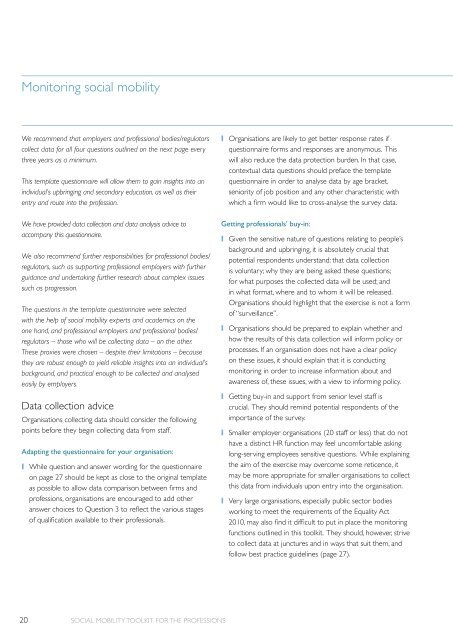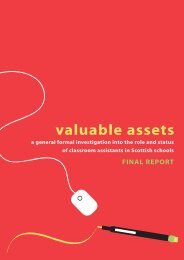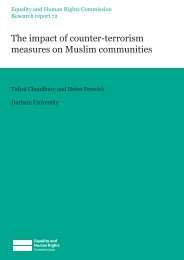Social Mobility Toolkit for the Professions - Equality and Human ...
Social Mobility Toolkit for the Professions - Equality and Human ...
Social Mobility Toolkit for the Professions - Equality and Human ...
Create successful ePaper yourself
Turn your PDF publications into a flip-book with our unique Google optimized e-Paper software.
Monitoring social mobility<br />
We recommend that employers <strong>and</strong> professional bodies/regulators<br />
collect data <strong>for</strong> all four questions outlined on <strong>the</strong> next page every<br />
three years as a minimum.<br />
This template questionnaire will allow <strong>the</strong>m to gain insights into an<br />
individual’s upbringing <strong>and</strong> secondary education, as well as <strong>the</strong>ir<br />
entry <strong>and</strong> route into <strong>the</strong> profession.<br />
We have provided data collection <strong>and</strong> data analysis advice to<br />
accompany this questionnaire.<br />
We also recommend fur<strong>the</strong>r responsibilities <strong>for</strong> professional bodies/<br />
regulators, such as supporting professional employers with fur<strong>the</strong>r<br />
guidance <strong>and</strong> undertaking fur<strong>the</strong>r research about complex issues<br />
such as progression.<br />
The questions in <strong>the</strong> template questionnaire were selected<br />
with <strong>the</strong> help of social mobility experts <strong>and</strong> academics on <strong>the</strong><br />
one h<strong>and</strong>, <strong>and</strong> professional employers <strong>and</strong> professional bodies/<br />
regulators – those who will be collecting data – on <strong>the</strong> o<strong>the</strong>r.<br />
These proxies were chosen – despite <strong>the</strong>ir limitations – because<br />
<strong>the</strong>y are robust enough to yield reliable insights into an individual’s<br />
background, <strong>and</strong> practical enough to be collected <strong>and</strong> analysed<br />
easily by employers.<br />
Data collection advice<br />
organisations collecting data should consider <strong>the</strong> following<br />
points be<strong>for</strong>e <strong>the</strong>y begin collecting data from staff.<br />
adapting <strong>the</strong> questionnaire <strong>for</strong> your organisation:<br />
� While question <strong>and</strong> answer wording <strong>for</strong> <strong>the</strong> questionnaire<br />
on page 27 should be kept as close to <strong>the</strong> original template<br />
as possible to allow data comparison between firms <strong>and</strong><br />
professions, organisations are encouraged to add o<strong>the</strong>r<br />
answer choices to Question 3 to reflect <strong>the</strong> various stages<br />
of qualification available to <strong>the</strong>ir professionals.<br />
20 <strong>Social</strong> <strong>Mobility</strong> toolkit For <strong>the</strong> proFeSSionS<br />
� organisations are likely to get better response rates if<br />
questionnaire <strong>for</strong>ms <strong>and</strong> responses are anonymous. this<br />
will also reduce <strong>the</strong> data protection burden. in that case,<br />
contextual data questions should preface <strong>the</strong> template<br />
questionnaire in order to analyse data by age bracket,<br />
seniority of job position <strong>and</strong> any o<strong>the</strong>r characteristic with<br />
which a firm would like to cross-analyse <strong>the</strong> survey data.<br />
Getting professionals’ buy-in:<br />
� Given <strong>the</strong> sensitive nature of questions relating to people’s<br />
background <strong>and</strong> upbringing, it is absolutely crucial that<br />
potential respondents underst<strong>and</strong>: that data collection<br />
is voluntary; why <strong>the</strong>y are being asked <strong>the</strong>se questions;<br />
<strong>for</strong> what purposes <strong>the</strong> collected data will be used; <strong>and</strong><br />
in what <strong>for</strong>mat, where <strong>and</strong> to whom it will be released.<br />
organisations should highlight that <strong>the</strong> exercise is not a <strong>for</strong>m<br />
of “surveillance”.<br />
� organisations should be prepared to explain whe<strong>the</strong>r <strong>and</strong><br />
how <strong>the</strong> results of this data collection will in<strong>for</strong>m policy or<br />
processes. if an organisation does not have a clear policy<br />
on <strong>the</strong>se issues, it should explain that it is conducting<br />
monitoring in order to increase in<strong>for</strong>mation about <strong>and</strong><br />
awareness of, <strong>the</strong>se issues, with a view to in<strong>for</strong>ming policy.<br />
� Getting buy-in <strong>and</strong> support from senior level staff is<br />
crucial. <strong>the</strong>y should remind potential respondents of <strong>the</strong><br />
importance of <strong>the</strong> survey.<br />
� Smaller employer organisations (20 staff or less) that do not<br />
have a distinct hr function may feel uncom<strong>for</strong>table asking<br />
long-serving employees sensitive questions. While explaining<br />
<strong>the</strong> aim of <strong>the</strong> exercise may overcome some reticence, it<br />
may be more appropriate <strong>for</strong> smaller organisations to collect<br />
this data from individuals upon entry into <strong>the</strong> organisation.<br />
� Very large organisations, especially public sector bodies<br />
working to meet <strong>the</strong> requirements of <strong>the</strong> equality act<br />
2010, may also find it difficult to put in place <strong>the</strong> monitoring<br />
functions outlined in this toolkit. <strong>the</strong>y should, however, strive<br />
to collect data at junctures <strong>and</strong> in ways that suit <strong>the</strong>m, <strong>and</strong><br />
follow best practice guidelines (page 27).












